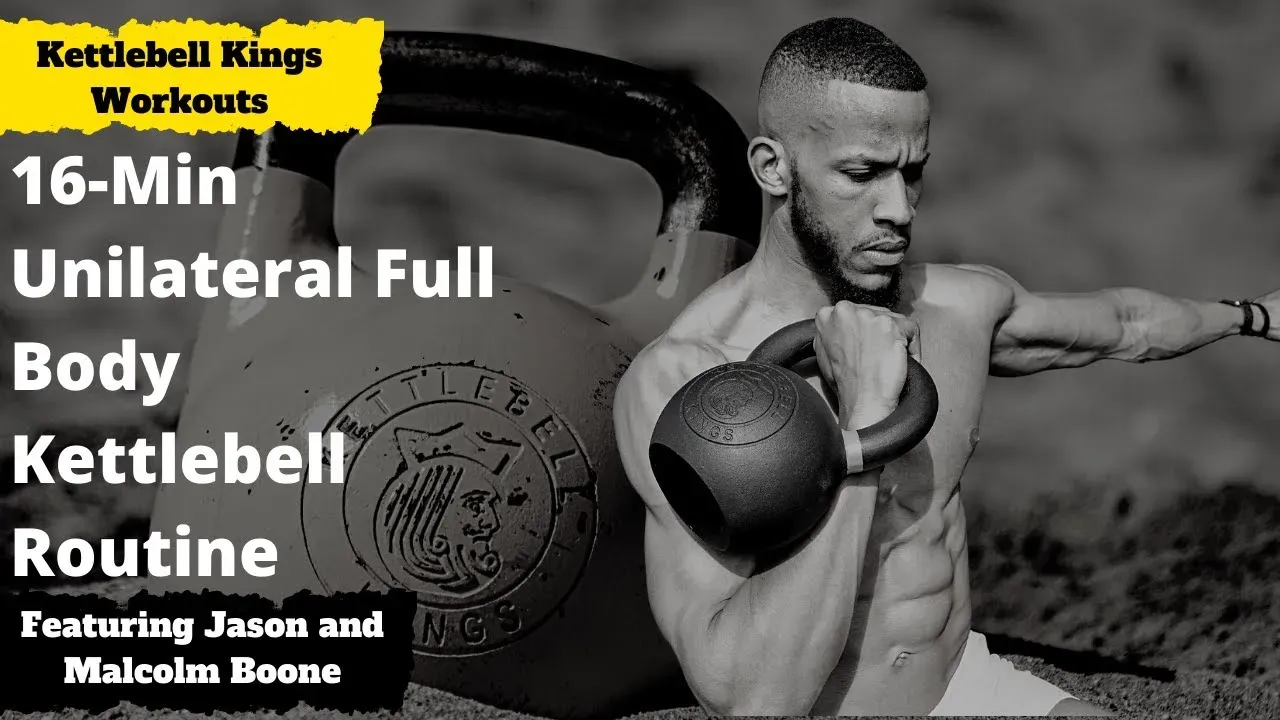Table of Contents
Ever feel like one side of your body does all the heavy lifting? Like your left arm is just along for the ride during a press, or your right leg is the only one showing up for squats? You're not alone. Most people have muscle imbalances, often without even realizing it until something feels "off" or a nagging ache pops up. Ignoring this asymmetry is a one-way ticket to plateaus, frustration, and potentially injury down the road.
Why Train One Side? The Power of Unilateral Kettlebell Exercises

Why Train One Side? The Power of Unilateral Kettlebell Exercises
Addressing the Imbalance Issue
Look, let's be honest. Most of us aren't perfectly symmetrical. Life happens – maybe you always carry your bag on one shoulder, favor one leg when standing, or your job involves repetitive motions on one side. Over time, this builds imbalances. Your dominant side gets stronger, your non-dominant side lags behind, and suddenly, simple movements feel awkward or even painful.
Bilateral training, using both limbs at once like a barbell squat or bench press, is great for overall strength, but it often lets your stronger side compensate for the weaker one. You might be lifting impressive weight, but you're just reinforcing that imbalance. That's why diving intounilateral kettlebell exercisesis so crucial. They force each side to work independently, exposing those hidden weaknesses and giving you a direct path to evening things out.
Building Real-World Strength and Stability
Training one side at a time with a kettlebell isn't just about fixing aesthetics or preventing future aches. It's about building functional strength that translates directly to real life. Think about carrying groceries, lifting a kid, or even just walking – you're constantly shifting weight and stabilizing through your core with one limb bearing the load.
When you perform a single-arm kettlebell press or a single-leg deadlift, your body has to fight rotation and maintain balance in a way that a bilateral movement doesn't require. This fires up your core stabilizers, obliques, and smaller supporting muscles like crazy. It's a different kind of challenge, one that builds a more resilient and capable body from the ground up. You're not just moving weight; you're mastering control under load, which is arguably more valuable.
Here are some key benefits you gain from unilateral kettlebell exercises:
- Identifies and corrects muscle imbalances.
- Significantly improves core strength and stability.
- Enhances balance and coordination.
- Reduces the risk of injury associated with asymmetry.
- Builds functional strength for daily activities and sports.
- Requires less weight to achieve a significant training stimulus.
Mastering Core Strength with Unilateral Kettlebell Exercises

Mastering Core Strength with Unilateral Kettlebell Exercises
Fighting the Twist: How Asymmetry Builds Iron Abs
let's talk core. Forget endless crunches; that's not how your core really works in the wild. Your core's main job isn't just flexing forward; it's preventing unwanted movement, especially rotation and side-bending. This is whereMastering Core Strength with Unilateral Kettlebell Exercisesshines. When you're holding a heavy kettlebell in just one hand – say, during a single-arm carry or a one-sided rack hold – your body instantly reacts to the uneven load. It tries to twist and lean away from the weight.
Your core muscles, particularly the obliques, transverse abdominis, and quadratus lumborum, have to fire like crazy just to keep you upright and stable. They're not just moving you; they're *resisting* movement. This anti-rotation and anti-lateral flexion work is incredibly effective at building a strong, functional core that protects your spine and improves performance in pretty much everything else you do. It's the difference between a wobbly tower and a solid concrete pillar.
Beyond the Six-Pack: Engaging the Deep Stabilizers
It's easy to think of core strength as just having visible abs, but the real power comes from the deep, internal muscles you can't see. These are the guys responsible for stabilizing your spine and pelvis. Unilateral kettlebell work hits these deep stabilizers hard. Take a single-arm swing, for instance. As the bell flies forward, your core braces against the force pulling you off-balance. In a single-leg deadlift, your core and hip stabilizers work together to keep your pelvis level.
This constant demand for stabilization under an asymmetrical load builds resilience you just don't get from balanced movements. It teaches your body to work as a cohesive unit, linking your upper and lower body through a rock-solid midsection. It's less about superficial muscle hypertrophy and more about building a truly robust engine for all your movements.
What kind of core work are you missing out on with just bilateral lifts?
- Anti-rotation strength
- Anti-lateral flexion strength
- Improved intermuscular coordination
- Better spinal stability under uneven loads
- Enhanced proprioception (body awareness)
Key Unilateral Kettlebell Exercises You Need to Know

Key Unilateral Kettlebell Exercises You Need to Know
The Dynamic Duo: Swings and Cleans
Alright, so you're ready to put this unilateral talk into action. Where do you start? You absolutely need to get familiar with the single-arm kettlebell swing. This isn't just a warm-up or conditioning move; it's a powerhouse for building explosive hip drive and, crucially for our topic, core stability. With the weight in one hand, your body immediately wants to twist. Your obliques, those unsung heroes of core strength, have to work overtime to keep your spine straight and your power directed forward. It's a brutal but effective way to build anti-rotation strength.
Then there's the single-arm clean. This move demands coordination and power as you transition the bell from the swing or deadlift position to the rack position at your shoulder. Again, the asymmetrical load forces your core to brace hard to prevent leaning or twisting. Mastering the single-arm clean is a gateway to overhead movements and builds serious athleticism. These twounilateral kettlebell exercisesshould be staples in your routine if you're serious about balanced power.
Grinds and Carries: Building Resilient Strength
Beyond the dynamic lifts, you have the "grind" movements and carries, which build strength and stability under tension. The single-arm bent-over row, for example, hammers your lats and upper back, but the unilateral nature means your core and lower back have to stabilize against the pull of the weight, preventing rotation. It's a different challenge than a two-arm row and often highlights which side is weaker.
Single-leg deadlifts with a kettlebell are another non-negotiable. Holding the weight in the opposite hand of your standing leg (contralateral loading) seriously challenges your balance, hip stability, and core. You can also hold it on the same side (ipsilateral loading) for a different kind of challenge. Finally, never underestimate the power of carries. A single kettlebell suitcase carry or farmer's walk looks simple, but try walking 50 yards with a heavy bell in one hand. Your entire side body, from your grip down to your obliques and hips, is screaming as it fights to keep you from tipping over. These are pure, functional strength builders.
Add these unilateral kettlebell exercises to your repertoire:
- Single-Arm Kettlebell Swing
- Single-Arm Kettlebell Clean
- Single-Arm Bent-Over Row
- Single-Leg Kettlebell Deadlift (Contralateral or Ipsilateral)
- Single Kettlebell Suitcase Carry
- Single Kettlebell Farmer's Walk
Programming Unilateral Kettlebell Exercises for Results

Programming Unilateral Kettlebell Exercises for Results
Integrating Single-Side Work into Your Routine
Alright, so you're sold on the idea ofProgramming Unilateral Kettlebell Exercises for Results. The big question now is, how do you actually fit this stuff into your existing training? You don't need to ditch everything else and go full unilateral, though some days dedicated to it are great. A smart approach is to integrate these movements. Maybe you swap out your barbell rows for single-arm rows on certain days, or replace your regular deadlifts with single-leg variations for a phase. You could also add unilateral carries at the end of a workout as a finisher. The key is consistency and listening to your body. Start light, focus on perfect form, and gradually increase the weight or volume as you feel your stability improve. Don't just toss them in randomly; think about how they complement your bilateral lifts and address your specific weaknesses.
Consider these points when adding unilateral exercises:
- Start with lighter weights than you think you need.
- Prioritize perfect form over lifting heavy.
- Balance unilateral pushes (like single-arm presses) with unilateral pulls (like single-arm rows).
- Include both dynamic (swings, cleans) and grind (carries, presses) movements.
- Don't neglect single-leg work; it's crucial for lower body balance.
- Track your progress on both sides to see imbalances decrease.
Avoiding Pitfalls in Your Unilateral Kettlebell Exercises Practice

Avoiding Pitfalls in Your Unilateral Kettlebell Exercises Practice
Don't Rush the Weight, Master the Movement
So, you're feeling strong with those single-arm swings and carries? Great. Now, resist the urge to immediately grab the heaviest kettlebell you can manage. This is probably the biggest mistake people make when starting out withunilateral kettlebell exercises. They treat it like bilateral lifting where you just add weight to the bar. With one-sided work, the challenge isn't just moving the weight; it's controlling it, stabilizing against it, and maintaining perfect posture while your body screams about the uneven load.
Trying to lift too heavy too soon will just reinforce bad habits and imbalances, or worse, lead to injury. You'll compensate, twist, and turn into a pretzel trying to muscle the weight up instead of letting your core and stabilizers do their job. Think of it like learning to ride a bike with one hand – you wouldn't start on a mountain trail with a lead weight attached to the handlebars. Master the balance and control first with a lighter bell, then gradually increase the resistance as your stability improves.
Ignoring Your Weaker Side (We See You)
It's tempting, isn't it? Your dominant side feels smooth, strong, and capable with these unilateral movements. Your non-dominant side feels… well, like a floppy noodle with questionable intentions. The pitfall here is spending more time on the side that feels easy and rushing through the side that feels hard. This completely defeats the purpose of usingunilateral kettlebell exercises.
You're trying to fix imbalances, remember? That means giving your weaker side the attention it desperately needs. A good rule of thumb is to always start with your weaker side. Do your prescribed reps or time on that side, then match that on your stronger side. Never do more on the stronger side just because you can. It might feel frustrating initially, but this deliberate focus is how you actually close the strength gap and build balanced power.
Common signs you're favoring your dominant side:
- You always start sets on the same side.
- The weight feels significantly heavier or harder to control on one side.
- Your form breaks down much faster on one side.
- You subconsciously shorten the range of motion on your weaker side.
- You avoid certain unilateral exercises because one side feels "too hard."
Skipping the Setup and Bracing
Kettlebell training, especially unilateral work, demands tension. You can't just pick up the bell and wing it. A major pitfall is neglecting the crucial setup and bracing required before and during each rep. Before you initiate a swing, clean, press, or carry, you need to create tension throughout your body. This means gripping the floor with your feet, squeezing your glutes, bracing your abs hard as if you're about to get punched, and pulling your lats down.
With unilateral movements, this full-body tension is even more critical because you're actively fighting asymmetrical forces. If your core is soft, your shoulders are relaxed, or your glutes aren't engaged, that uneven load will pull you out of alignment, putting unnecessary stress on your joints and spine. Proper bracing turns your torso into a solid platform from which your limbs can move powerfully and safely. Don't treat the setup as optional; it's the foundation for effective and safeunilateral kettlebell exercises.
The Payoff of Unilateral Work
Stepping into the world of unilateral kettlebell exercises isn't about making things harder just because you can. It's a strategic move to build a body that performs better, moves more efficiently, and resists injury. By deliberately challenging one side at a time, you expose weaknesses, forge a rock-solid core, and create the kind of balanced strength that translates directly to real-world activities, not just gym numbers. Stop letting your dominant side pick up the slack. Start training unilaterally and feel the difference a truly balanced body makes.